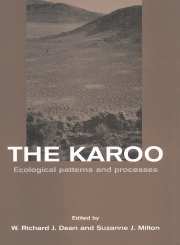Book contents
- Frontmatter
- Contents
- List of contributors
- Foreword
- Preface
- Acknowledgements
- Part one Biogeographic patterns and the driving variables
- Part two Form and function
- Part three Dynamics
- Part four Human impacts
- Part five Comparisons
- 18 Comparison of ecosystem processes in the Nama-karoo and other deserts
- 19 The succulent karoo in a global context: plant structural and functional comparison with North American winter-rainfall deserts
- 20 The karoo: past and future
- References
- Index
19 - The succulent karoo in a global context: plant structural and functional comparison with North American winter-rainfall deserts
Published online by Cambridge University Press: 23 December 2009
- Frontmatter
- Contents
- List of contributors
- Foreword
- Preface
- Acknowledgements
- Part one Biogeographic patterns and the driving variables
- Part two Form and function
- Part three Dynamics
- Part four Human impacts
- Part five Comparisons
- 18 Comparison of ecosystem processes in the Nama-karoo and other deserts
- 19 The succulent karoo in a global context: plant structural and functional comparison with North American winter-rainfall deserts
- 20 The karoo: past and future
- References
- Index
Summary
Introduction
In the past decade, research in the succulent karoo biome of southern Africa has highlighted the unique aspects of this winter-rainfall desert compared to other deserts with similar climates (Cowling et al., 1989; Cowling et al., 1994). In addition to long-lived succulents (e.g. Aloe, Pachypodium), the succulent karoo has a remarkable dominance and unique diversity of short to medium-lived leaf-succulent shrubs as well as a rich geophyte flora. In contrast, this biome supports comparatively few drought-deciduous shrubs and other long-lived perennials (Esler and Rundel in press). Despite a lack of structural diversity, due partly to growth form uniformity as discussed below, plant species diversity at both the local and regional scales in the succulent karoo is undoubtedly the highest recorded for any arid region in the world (Cowling et al., 1989; Cowling and Hilton-Taylor, this volume). The floral diversity of the biome is unparalleled for any winter-rainfall desert – 4849 species occurring in approximately 100 000 km2 (Hilton-Taylor, 1996). Approximately 30% of the world's succulent species are located in this small area (Van Jaarsveld, 1987; Smith et al., 1993). Notable families with leaf- or stemsucculent species are the Aizoaceae (including Mesembryanthema) (861 taxa, 102 genera, Hilton-Taylor 1996), Asteraceae, Liliaceae, Geraniaceae, Euphorbiaceae, Asclepiadaceae and the Crassulaceae. Many of these species are rare and endangered, and approximately 40% are endemic (Hilton-Taylor, 1996). These features make the succulent karoo a unique biome of global importance.
Using a comparative approach, we propose an empirical model to explain how the special climatic conditions of the succulent karoo have provided a unique selective regime which has led to the evolution of such a diverse and unusual desert flora.
- Type
- Chapter
- Information
- The KarooEcological Patterns and Processes, pp. 303 - 313Publisher: Cambridge University PressPrint publication year: 1999
- 9
- Cited by



